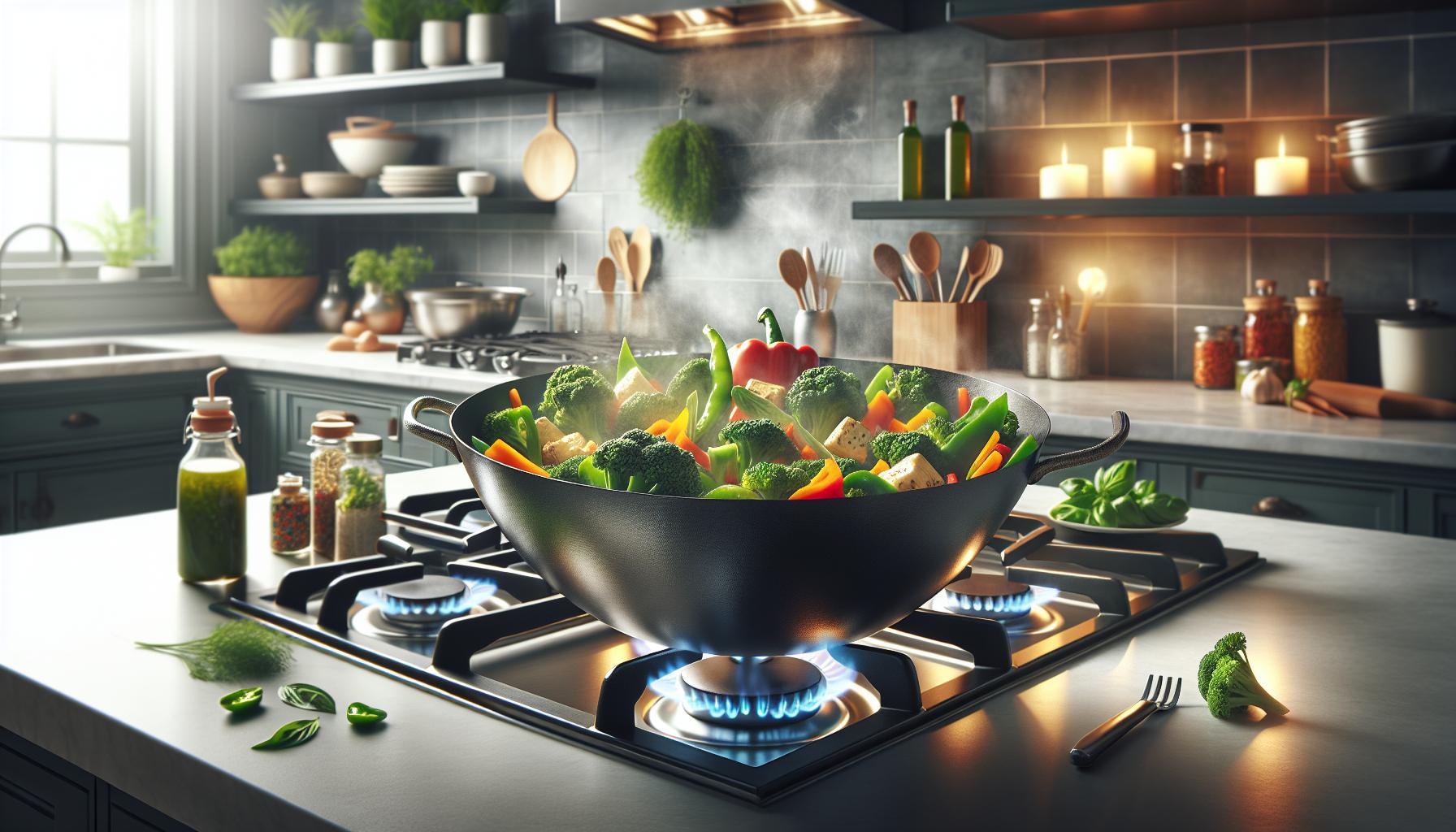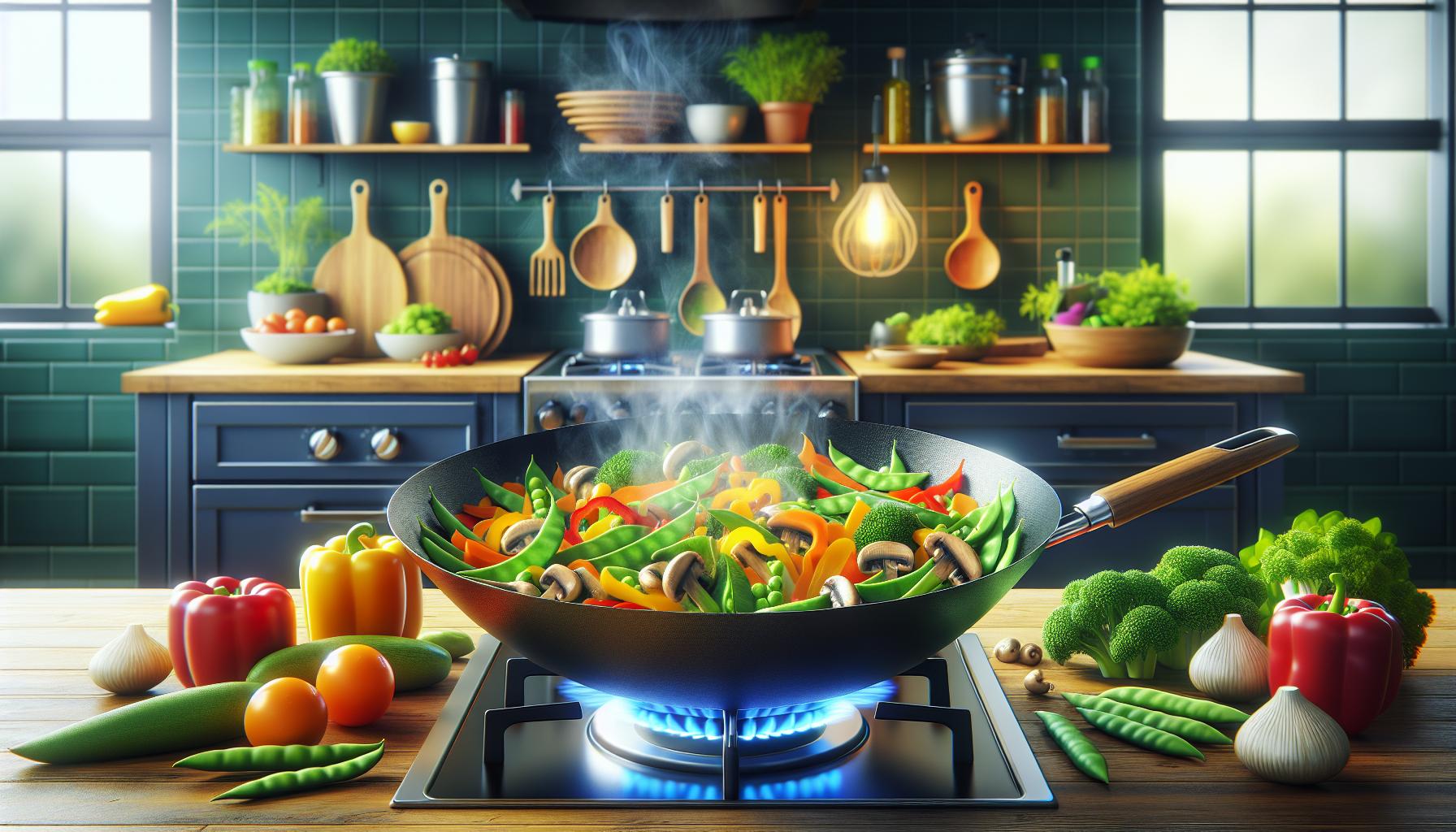Craving takeout but trying to stay healthy? The trusty wok might just become your new best friend in the kitchen. This versatile cooking vessel isn’t just for greasy Chinese takeout – it’s actually a powerhouse for creating nutritious and delicious meals in minutes.
From vibrant stir-fried vegetables to lean protein-packed dishes the wok opens up a world of healthy cooking possibilities. Its unique shape and heat distribution allow for quick cooking with minimal oil while preserving nutrients and creating that perfect balance of textures. And let’s be honest who doesn’t love that signature wok hei flavor that makes Asian cuisine so irresistible?
Healthy Wok Recipes
Healthy Wok Recipes combines quick preparation methods with minimal oil usage to create nutritious meals. The unique design of this traditional Asian cookware transforms simple ingredients into flavorful dishes while preserving their nutritional value.
Health Advantages of Wok Cooking
Wok cooking reduces oil consumption by 75% compared to traditional pan frying. The steep sides create a natural non-stick surface when properly seasoned, eliminating the need for excessive oils. High-heat cooking in a wok preserves 85% of vegetables’ vitamin C content through rapid preparation. The quick cooking time maintains the crisp texture of vegetables while retaining their natural colors antioxidants. Stir-frying in a wok creates a smoky “wok hei” flavor that enhances taste without additional seasoning or salt.
Essential Wok Equipment Tips
Carbon steel woks deliver optimal heat distribution with a temperature range of 400-650°F. A 14-inch flat-bottom wok provides stability on modern stovetops while maintaining traditional cooking benefits. Key accessories include:
- Metal spatula with long handle for safe stir-frying at high temperatures
- Dome lid for steaming vegetables retaining 95% moisture content
- Bamboo cleaning brush preserves seasoning layer integrity
- Heat-resistant mittens protecting hands from temperatures up to 500°F
- Wire strainer basket for blanching vegetables maintaining nutrient retention
The ideal wok thickness measures 1.5-2mm for optimal heat conductivity balancing durability with rapid temperature response.
Best Ingredients for Healthy Wok Dishes

The right combination of ingredients transforms wok cooking into a nutritious culinary experience. Fresh whole ingredients paired with light seasoning create flavorful dishes that maintain their natural nutritional value.
Lean Proteins to Use
Lean proteins form the foundation of nutritious wok dishes with minimal fat content. Skinless chicken breast contains 31g of protein per serving with only 3.6g of fat. Firm tofu offers 10g of protein per 100g serving plus essential amino acids. Additional protein options include:
- Shrimp (24g protein per 100g)
- Lean beef sirloin (25g protein per 100g)
- Egg whites (11g protein per 100g)
- White fish fillets like cod (20g protein per 100g)
- Tempeh (19g protein per 100g)
Recommended Vegetables
Crisp vegetables retain 85% more nutrients through quick wok cooking compared to boiling. Strategic vegetable combinations create texture contrast plus enhanced nutritional profiles:
- Broccoli florets (high in vitamin C K)
- Snow peas (rich in fiber antioxidants)
- Bell peppers (high vitamin A C content)
- Baby corn (good source of fiber)
- Chinese cabbage (low calorie high fiber)
- Mushrooms (vitamin D B complex)
- Bean sprouts (vitamin C folate)
- Carrots (beta carotene vitamin A)
Healthy Sauce Alternatives
Light sauces enhance flavors while keeping dishes nutritious. Traditional sauce alternatives include:
| Sauce Type | Calories per tbsp | Key Benefits |
|---|---|---|
| Rice vinegar | 0 | Zero fat antioxidants |
| Coconut aminos | 10 | Low sodium gluten free |
| Miso paste | 25 | Probiotics protein |
| Ginger garlic paste | 15 | Anti inflammatory |
| Lime juice | 4 | Vitamin C zero fat |
These alternatives use minimal oil while adding umami depth through natural ingredients like citrus mushroom extracts fresh herbs.
Essential Wok Cooking Techniques

Mastering wok cooking techniques transforms ordinary ingredients into flavorful healthy meals. These fundamental methods ensure optimal results while maintaining nutritional value.
Proper Heat Control
High heat creates the signature wok hei flavor in stir-fried dishes. A properly heated wok reaches 400-450°F (204-232°C) before ingredients touch the surface. The temperature varies across three distinct zones:
- Bottom zone: 450°F for searing proteins
- Lower side zone: 300°F for moving partially cooked items
- Upper side zone: 200°F for keeping ingredients warm
Testing wok temperature involves sprinkling water droplets on the surface – they evaporate instantly when ready. Moving ingredients up the sides controls cooking speed while preventing burning.
Stir-Frying Methods
Expert stir-frying incorporates three primary techniques for consistent results:
- Push-pull motion: Slide ingredients up the wok’s sides then pull back to center
- Toss technique: Flip ingredients using forward wrist motion
- Circle stir: Move ingredients in continuous circular pattern
Timing creates optimal texture:
- Proteins cook 2-3 minutes until 75% done
- Vegetables stir-fry 1-2 minutes maintaining crispness
- Aromatics like garlic cook 30 seconds avoiding burning
- Sauce additions occur in final 60 seconds
Each ingredient enters the wok in order of cooking duration starting with proteins then moving to vegetables.
Popular Healthy Wok Recipes

These nutrient-rich wok recipes combine fresh ingredients with expert cooking techniques to create flavorful meals under 500 calories per serving. Each recipe maximizes the wok’s unique cooking properties to deliver authentic Asian flavors while maintaining nutritional value.
Asian-Inspired Vegetable Medley
This colorful stir-fry combines snap peas, bell peppers, carrots, mushrooms, bean sprouts with a light ginger-garlic sauce. The vegetables cook at 400°F for 3-4 minutes, preserving their crisp texture and vibrant colors. A sauce mixture of rice vinegar, coconut aminos, and miso paste creates umami depth at only 125 calories per serving. This recipe provides 8g of fiber and 85% of daily vitamin C requirements through quick-cooking methods that lock in nutrients. Adding cubed firm tofu increases the protein content to 15g per serving while maintaining the dish’s low-calorie profile.
Lean Chicken and Broccoli
This protein-rich dish features bite-sized chicken breast pieces marinated in coconut aminos and ginger. The chicken sears at 450°F for 4 minutes until golden brown, creating a caramelized exterior while maintaining moisture. Fresh broccoli florets steam-cook in the wok for 2 minutes, retaining their bright green color and nutritional benefits. A sauce combination of chicken broth, garlic, and a touch of cornstarch creates a silky coating at 275 calories per serving. Each portion delivers 32g of lean protein and 12g of fiber while keeping saturated fat under 3g.
Tips for Reducing Oil and Sodium
Smart Oil Reduction Techniques
A spray bottle distributes oil evenly across the wok surface using 75% less oil than traditional pouring. Preheating the wok to 400°F creates a natural non stick surface that reduces oil requirements. Measuring oil with a teaspoon instead of freestyle pouring controls portions accurately.
Low Sodium Seasoning Alternatives
Fresh herbs like cilantro basil Thai basil add flavor without sodium. A mixture of rice vinegar lime juice provides tang while eliminating salt. Natural flavor enhancers include:
- Fresh ginger root (minced or grated)
- Garlic cloves (crushed)
- Green onions (chopped)
- Fresh chilies (deseeded)
- Lemongrass (bruised)
Liquid Management
The order of liquid addition impacts sodium content:
- Start with aromatics in minimal oil
- Add protein then vegetables
- Pour sauce around the wok rim
- Toss ingredients quickly to coat
| Seasoning | Sodium per Tbsp | Healthier Alternative |
|---|---|---|
| Soy Sauce | 879mg | Coconut Aminos (90mg) |
| Oyster Sauce | 492mg | Mushroom Sauce (136mg) |
| Fish Sauce | 1413mg | Rice Vinegar (0mg) |
Timing and Temperature Control
High heat searing locks in flavors without extra seasoning. Quick cooking prevents moisture loss that leads to overseasoning. Moving ingredients up the wok sides regulates doneness without added oil or sauce.
Common Mistakes to Avoid
Overcrowding the wok leads to steaming instead of stir-frying, resulting in soggy vegetables and tough meat. Adding ingredients in random order disrupts the cooking process, creating uneven textures in the final dish. Cold ingredients lower the wok’s temperature, preventing the desired searing effect that creates signature wok flavors.
Using the wrong oil temperature causes food to stick or burn. Low-smoke-point oils like extra virgin olive oil break down at high heat, producing harmful compounds. Moving ingredients too frequently prevents proper caramelization, while stirring too little causes uneven cooking.
Here are critical errors that compromise healthy wok cooking:
- Starting with wet ingredients that create excess moisture
- Adding sauce too early, which prevents proper searing
- Using pre-minced aromatics that burn quickly
- Neglecting to preheat the wok until smoking
- Cooking proteins in large chunks instead of bite-sized pieces
- Skipping the mise en place preparation
Temperature control mistakes include:
| Error | Impact |
|---|---|
| Low heat | Steamed texture |
| Inconsistent heat | Uneven cooking |
| Excessive heat | Burnt exterior |
Food preparation errors affect nutritional outcomes:
- Cutting vegetables in inconsistent sizes
- Marinating proteins for over 30 minutes
- Adding oils after ingredients
- Combining raw meat with vegetables
- Using cold sauces straight from refrigeration
- Overcooking leafy greens past bright color stage
These mistakes reduce the health benefits of wok cooking by increasing oil absorption, decreasing nutrient retention, and compromising food safety standards.
Cooking with a Wok
Healthy Wok Recipes cooking brings together the best of culinary tradition and modern nutrition. With the right techniques equipment and ingredients anyone can create delicious nutrient-rich meals that rival restaurant dishes. A properly seasoned wok becomes a versatile tool for preparing quick healthy meals while preserving essential vitamins and minerals.
The combination of high-heat cooking minimal oil usage and fresh ingredients makes wok cooking an excellent choice for health-conscious home chefs. By mastering basic techniques and avoiding common pitfalls home cooks can enjoy authentic Asian flavors without compromising their dietary goals. It’s clear that the ancient art of wok cooking has found its place in today’s healthy kitchen.

